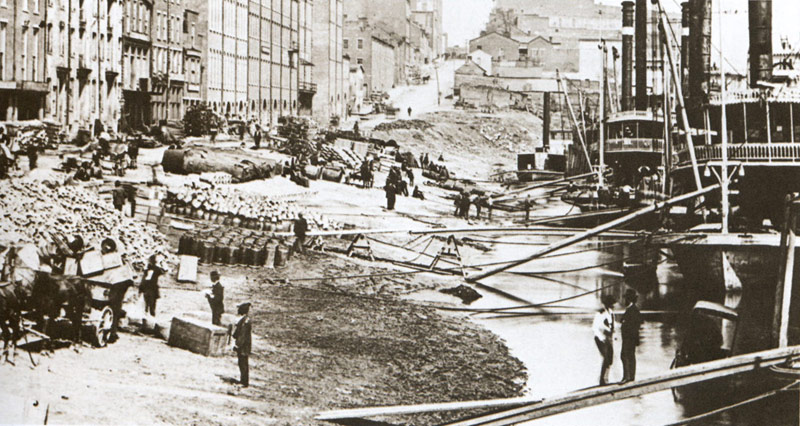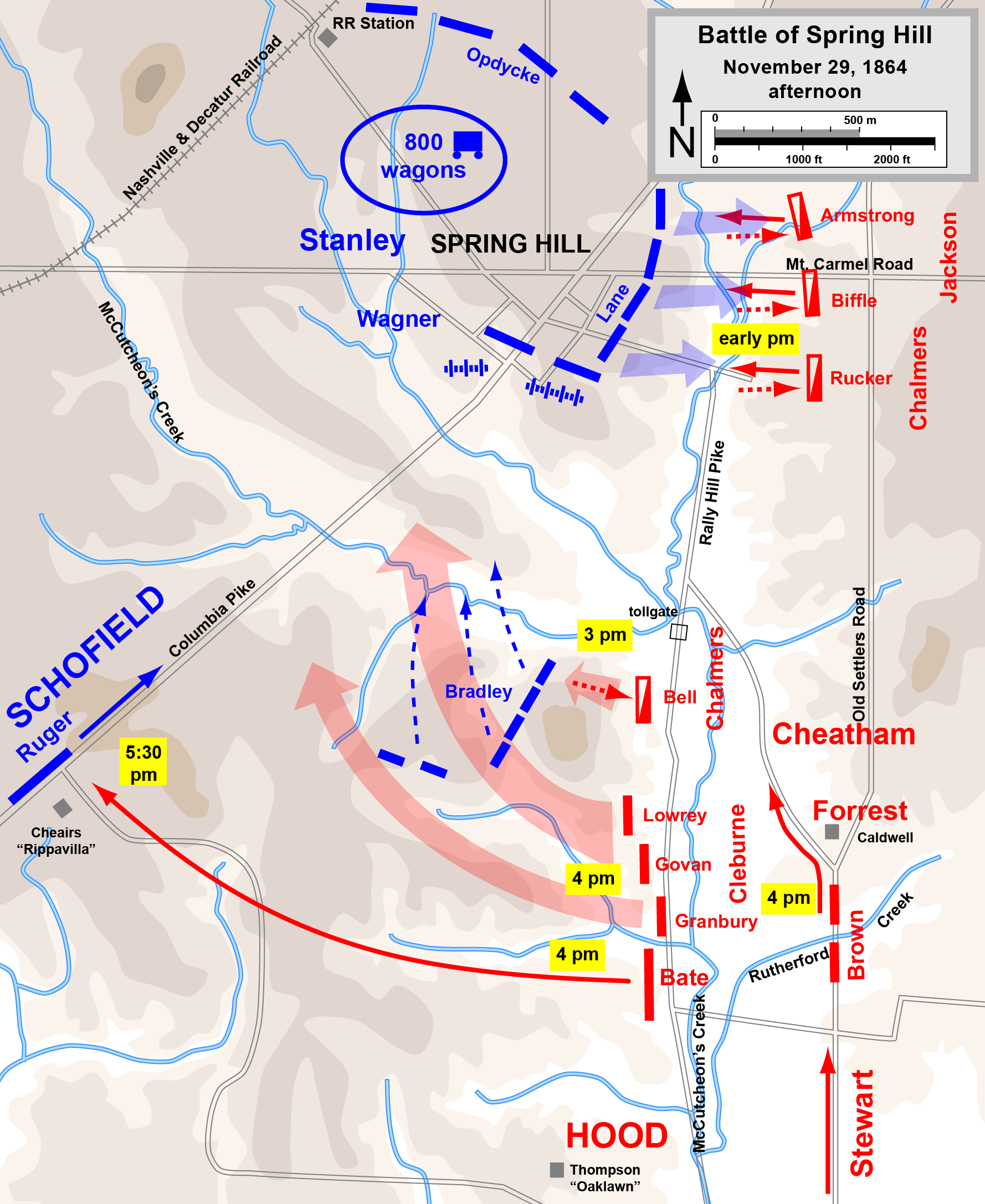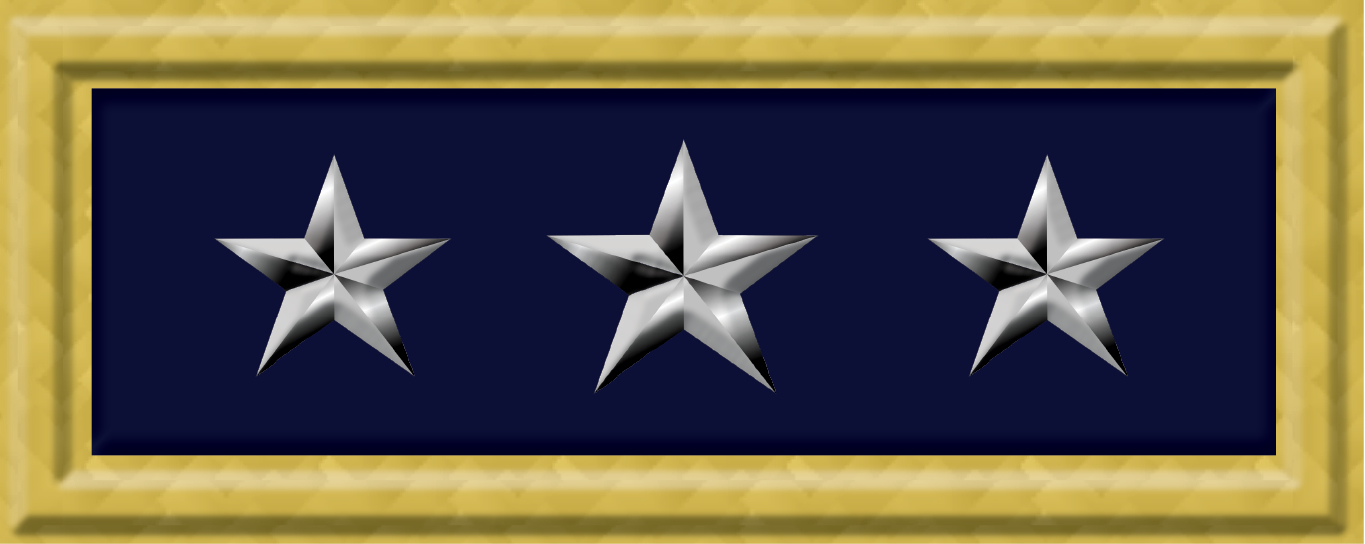|
Benjamin Cheatham
Benjamin Franklin "Frank" Cheatham (October 20, 1820 – September 4, 1886) was a Tennessee planter, California gold miner, and a general in the Confederate States Army during the American Civil War. He served in the Army of Tennessee, inflicting many casualties on Gen. Sherman at Kennesaw Mountain, Georgia, but taking the blame for General Schofield's escape at Spring Hill, Tennessee – a major factor in the Confederate defeat at Franklin, Tennessee. Early life and education Cheatham was born in Nashville, Tennessee on a plantation called Westover, which in its prime consisted of three thousand acres (12 km2). He was born into two of the most prominent families of the middle Tennessee elite of the slave society. His mother was descended from General James Robertson, the founder of Nashville and "father" of Middle Tennessee, who came from Virginia. The Cheathams had been in middle Tennessee for two generations and become established as plantation owners, lawyers, doctors ... [...More Info...] [...Related Items...] OR: [Wikipedia] [Google] [Baidu] |
General Officers In The Confederate States Army
The general officers of the Confederate States Army (CSA) were the senior military leaders of the Confederacy during the American Civil War of 1861–1865. They were often former officers from the United States Army (the regular army) prior to the Civil War, while others were given the rank based on merit or when necessity demanded. Most Confederate generals needed confirmation from the Confederate Congress, much like prospective generals in the modern U.S. armed forces. Like all of the Confederacy's military forces, these generals answered to their civilian leadership, in particular Jefferson Davis, the South's president and therefore commander-in-chief of the Army, Navy, and the Marines of the Confederate States. History Much of the design of the Confederate States Army was based on the structure and customs of the U.S. Army when the Confederate Congress established their War Department on February 21, 1861.Eicher, p. 23. The Confederate Army was composed of three parts; t ... [...More Info...] [...Related Items...] OR: [Wikipedia] [Google] [Baidu] |
California Gold Rush
The California Gold Rush (1848–1855) was a gold rush that began on January 24, 1848, when gold was found by James W. Marshall at Sutter's Mill in Coloma, California. The news of gold brought approximately 300,000 people to California from the rest of the United States and abroad. The sudden influx of gold into the money supply reinvigorated the American economy; the sudden population increase allowed California to go rapidly to statehood, in the Compromise of 1850. The Gold Rush had severe effects on Native Californians and accelerated the Native American population's decline from disease, starvation and the California genocide. The effects of the Gold Rush were substantial. Whole indigenous societies were attacked and pushed off their lands by the gold-seekers, called "forty-niners" (referring to 1849, the peak year for Gold Rush immigration). Outside of California, the first to arrive were from Oregon, the Sandwich Islands (Hawaii) and Latin America in late 1848. Of th ... [...More Info...] [...Related Items...] OR: [Wikipedia] [Google] [Baidu] |
California
California is a U.S. state, state in the Western United States, located along the West Coast of the United States, Pacific Coast. With nearly 39.2million residents across a total area of approximately , it is the List of states and territories of the United States by population, most populous U.S. state and the List of U.S. states and territories by area, 3rd largest by area. It is also the most populated Administrative division, subnational entity in North America and the 34th most populous in the world. The Greater Los Angeles area and the San Francisco Bay Area are the nation's second and fifth most populous Statistical area (United States), urban regions respectively, with the former having more than 18.7million residents and the latter having over 9.6million. Sacramento, California, Sacramento is the state's capital, while Los Angeles is the List of largest California cities by population, most populous city in the state and the List of United States cities by population, ... [...More Info...] [...Related Items...] OR: [Wikipedia] [Google] [Baidu] |
Captain (United States)
In the United States uniformed services, captain is a commissioned-officer rank. In keeping with the traditions of the militaries of most nations, the rank varies between the services, being a senior rank in the naval services and a junior rank in the ground and air forces. Many fire departments and police departments in the United States also use the rank of captain as an officer in a specific unit. Usage For the naval rank, a captain is a senior officer of U.S. uniformed services pay grades O-6 (the sixth officer rank), typically commanding seagoing vessels, major aviation commands and shore installations. This rank is used by the U.S. Navy, U.S. Coast Guard, U.S. Public Health Service Commissioned Corps, the National Oceanic and Atmospheric Administration Commissioned Corps, and the U.S. Maritime Service. Seaborne services of the United States and many other nations refer to the officer in charge of any seagoing vessel as "captain" regardless of actual rank. For instance ... [...More Info...] [...Related Items...] OR: [Wikipedia] [Google] [Baidu] |
Nashville
Nashville is the capital city of the U.S. state of Tennessee and the seat of Davidson County. With a population of 689,447 at the 2020 U.S. census, Nashville is the most populous city in the state, 21st most-populous city in the U.S., and the fourth most populous city in the southeastern U.S. Located on the Cumberland River, the city is the center of the Nashville metropolitan area, which is one of the fastest growing in the nation. Named for Francis Nash, a general of the Continental Army during the American Revolutionary War, the city was founded in 1779. The city grew quickly due to its strategic location as a port on the Cumberland River and, in the 19th century, a railroad center. Nashville seceded with Tennessee during the American Civil War; in 1862 it was the first state capital in the Confederacy to be taken by Union forces. After the war, the city reclaimed its position and developed a manufacturing base. Since 1963, Nashville has had a consolidated city-county gov ... [...More Info...] [...Related Items...] OR: [Wikipedia] [Google] [Baidu] |
James Robertson (explorer)
James Robertson (June 28, 1742 – September 1, 1814) was an American explorer, soldier and Indian agent, and one of the founding fathers of what became the State of Tennessee. An early companion of explorer Daniel Boone, Robertson helped establish the Watauga Association in the early 1770s, and to defend Fort Watauga from an attack by Cherokee in 1776. In 1779, he co-founded what is now Nashville, and was instrumental in the settlement of Middle Tennessee. He served as a brigadier general in the Southwest Territory militia in the early 1790s, and as an Indian Commissioner in later life. Early life and education Robertson was born in 1742 in Brunswick County, Virginia, of Scots-Irish and English descent. Around 1749, his father relocated the family to Wake County, North Carolina. Robertson worked with his siblings on their family farm and had limited formal education, but he learned to track and hunt animals and know his way in the woods and waterways. Marriage and ca ... [...More Info...] [...Related Items...] OR: [Wikipedia] [Google] [Baidu] |
Battle Of Franklin (1864)
The Second Battle of Franklin was fought on November 30, 1864, in Franklin, Tennessee, as part of the Franklin–Nashville Campaign of the American Civil War. It was one of the worst disasters of the war for the Confederate States Army. Confederate Lt. Gen. John Bell Hood's Army of Tennessee conducted numerous frontal assaults against fortified positions occupied by the Union forces under Maj. Gen. John Schofield and was unable to prevent Schofield from executing a planned, orderly withdrawal to Nashville. The Confederate assault of six infantry divisions containing eighteen brigades with 100 regiments numbering almost 20,000 men, sometimes called the "Pickett's Charge of the West", resulted in devastating losses to the men and the leadership of the Army of Tennessee—fourteen Confederate generals (six killed, seven wounded, and one captured) and 55 regimental commanders were casualties. After its defeat against Maj. Gen. George H. Thomas in the subsequent Battle of Nashville, ... [...More Info...] [...Related Items...] OR: [Wikipedia] [Google] [Baidu] |
Battle Of Spring Hill
The Battle of Spring Hill was fought November 29, 1864, at Spring Hill, Tennessee, as part of the Franklin-Nashville Campaign of the American Civil War. The Confederate Army of Tennessee, commanded by Lt. Gen. John Bell Hood, attacked a Union force under Maj. Gen. John M. Schofield as it retreated from Columbia through Spring Hill. Because of a series of command failures, the Confederates were unable to inflict serious damage on the Federals and could not prevent their safe passage north to Franklin during the night. The next day, Hood pursued Schofield and attacked his fortifications in the Battle of Franklin, resulting in severe Confederate casualties. Background Following his defeat in the Atlanta Campaign, Hood had hoped to lure Maj. Gen. William T. Sherman into battle by disrupting his supply lines from Chattanooga to Atlanta. After a brief period in which he pursued Hood, Sherman elected instead to conduct his March to the Sea from Atlanta to Savannah, Georgia. He lef ... [...More Info...] [...Related Items...] OR: [Wikipedia] [Google] [Baidu] |
John Schofield
John McAllister Schofield (September 29, 1831 – March 4, 1906) was an American soldier who held major commands during the American Civil War. He was appointed U.S. Secretary of War (1868–1869) under President Andrew Johnson and later served as Commanding General of the United States Army (1888–1895). Early life John McAllister Schofield was born September 29, 1831, in Gerry, Chautauqua County, New York, the son of the Reverend James Schofield (1801–1888) and his first wife, the former Caroline (McAllister) Schofield (1810–1857). His father, a Baptist minister in Sinclairville became a domestic missionary and moved his family (which then included six children and would include 10 who survived infancy) to Bristol, Illinois. When John was 12, they finally settled in Freeport, Illinois, where Rev. Schofield became the town's first Baptist minister in 1845, and where he was ultimately buried in 1888. As a young man John Schofield was educated in the public schools, helped ... [...More Info...] [...Related Items...] OR: [Wikipedia] [Google] [Baidu] |
Battle Of Kennesaw Mountain
The Battle of Kennesaw Mountain was fought on June 27, 1864, during the Atlanta Campaign of the American Civil War. It was the most significant frontal assault launched by Union Maj. Gen. William T. Sherman against the Confederate Army of Tennessee under Gen. Joseph E. Johnston, ending in a tactical defeat for the Union forces. Strategically, however, the battle failed to deliver the result that the Confederacy desperately needed—namely a halt to Sherman's advance on Atlanta. Sherman's 1864 campaign against Atlanta, Georgia, was initially characterized by a series of flanking maneuvers against Johnston, each of which compelled the Confederate army to withdraw from heavily fortified positions with minimal casualties on either side. After two months and of such maneuvering, Sherman's path was blocked by imposing fortifications on Kennesaw Mountain, near Marietta, Georgia, and the Union general chose to change his tactics and ordered a large-scale frontal assault on June 27. Maj. ... [...More Info...] [...Related Items...] OR: [Wikipedia] [Google] [Baidu] |
William T
William is a male given name of Germanic origin.Hanks, Hardcastle and Hodges, ''Oxford Dictionary of First Names'', Oxford University Press, 2nd edition, , p. 276. It became very popular in the English language after the Norman conquest of England in 1066,All Things William"Meaning & Origin of the Name"/ref> and remained so throughout the Middle Ages and into the modern era. It is sometimes abbreviated "Wm." Shortened familiar versions in English include Will, Wills, Willy, Willie, Bill, and Billy. A common Irish form is Liam. Scottish diminutives include Wull, Willie or Wullie (as in Oor Wullie or the play ''Douglas''). Female forms are Willa, Willemina, Wilma and Wilhelmina. Etymology William is related to the given name ''Wilhelm'' (cf. Proto-Germanic ᚹᛁᛚᛃᚨᚺᛖᛚᛗᚨᛉ, ''*Wiljahelmaz'' > German ''Wilhelm'' and Old Norse ᚢᛁᛚᛋᛅᚼᛅᛚᛘᛅᛋ, ''Vilhjálmr''). By regular sound changes, the native, inherited English form of the name shoul ... [...More Info...] [...Related Items...] OR: [Wikipedia] [Google] [Baidu] |






